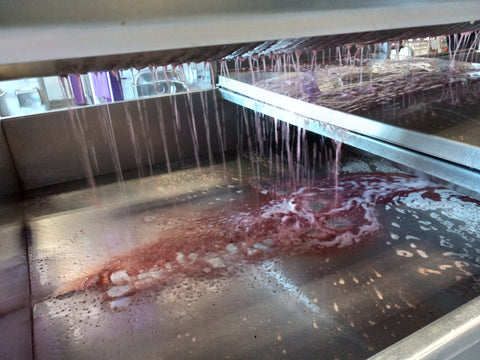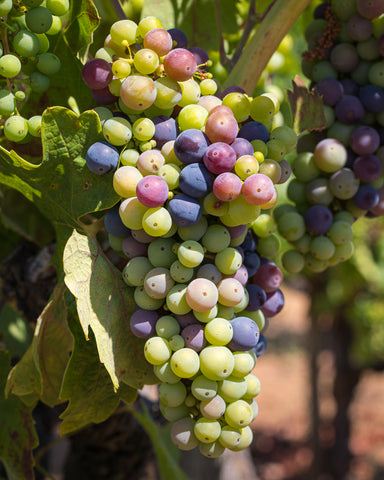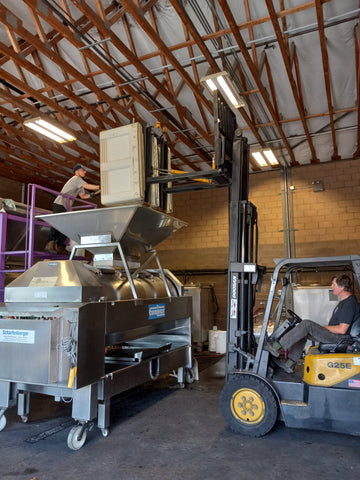
On This Harvest Season
Before the Harvest
Harvesttime, arriving sometime in autumn between late August and October, signals that fruit will soon be en route to the winery. Winemakers may hunger to see their ideals and identities reflected in the grapes that arrive, but the reality is that viticulturalists have already poured their hearts and souls for months into tending the plants. Like all practicalities of winemaking, harvest is not limited to one mere event. The activities and tasks of preparing for harvest span the features and feats of Paul Simon's Graceland album.

Fruit Quality
It's natural to be drawn to grapes only when the berries are fully ripened. Biting into tart, malic-acid laden fruit is no picnic. Nor is the sight or smell of green, rock-hard berry clusters that have yet to change color.
The transition from growing to ripening, and subsequent quality of grapes for wine, has very little to do with harvest. We aren't present in the vineyards to see early berry development, but that is the point when berries are most profoundly influenced: crop load, fruit distribution, canopy density, and water status are just a few of the modes and methods for enhancement of certain attributes. It's a time period that occurs between the fruit set, when flowers first form berries, and the onset of ripening.

Veraison
When forming a picture of ripeness, color change immediately comes to mind. The French term for this stage in winegrowing, veraison, translates to "change in the color of grape berries." Between July and August, grapes swell and soften to adopt their final form. Red varietals deepen to a purplish burgundy; white varietals turn a translucent gold.
This development period between veraison and ripening occurs mere weeks before picking. With all the focus on harvest, everything that has been done during veraison tends to be forgotten. Take irrigation, for example. Viticulturists typically follow a practice of increasing vine water stress up to veraison. After the ripening period, the irrigation amount picks up slightly: allowing the vines to remain healthy and functional, while also keeping them slightly stressed, maintains ripening in lieu of vegetative growth. With increased happiness in the vines comes increased sugar production, more sap pumped through the stalks, and plumper berries.

Irrigating Through the Seasons
But is there a danger of over-irrigation? Vines need a certain amount of water, which is exactly what growers invest in their plants. A sudden lack of water before harvest would actually leave fruit with no reserves for hydration in the soil; severe water stress will set in, causing berries to shrivel.
Much of the worry regarding irrigation prior to harvest stems from a fear of blowing up grapes with water. Thinking from a viticulturist perspective, a judicious amount of water is the most advisable way to keep vines from crashing and burning in a cringe-worthy Fast and Furious wipeout. Older styles of growing may have been based on overwatering; however, today's systematic watering styles ensure that vines won't experience that drastic of a change in water status. The fruit wouldn't blow up like a balloon. On the contrary, it would take inconceivably large amounts of water to dilute the berry juice.

Crop Thinning
There are upsides to water stress and there are also benefits to related practices. The trick is implementing these practices at the right time and the right place.
One method for crop level management is called cluster removal. This is the process of balancing out the vine by strategically removing clusters from each vine during or after veraison. The common practice used on the Central Coast for high end Pinot Noir vines is 1-2 clusters per shoot. This gives the cluster better air flow underneath the canopy and reduces the risk of disease pressure from mildew. Also, it helps balance out the crop for more even development as the clusters ripen during the long growing period.
The downside to cluster thinning is a topic of much discussion for vineyard managers, vineyard owners and winemakers. Do the benefits of dropping Pinot Noir clusters on the ground at $4,500/ton outweigh the costs? As a winemaker, you want the best possible fruit per your vineyard contract. As a vineyard manager, you want to deliver the high-quality product to your clients. As an owner of a vineyard, you want the highest return on your investment.
The protocol for dropping fruit is typically spelled out in the vineyard contract. A vineyard that does carry an excess load of clusters could take longer to ripen, which is more prone to mildew pressure and potentially less flavor development. Striking a balance between even ripening and full sugar accumulation during veraison is one of many aspects in crop load management that brings home a successful harvest.

Pre-Harvest Menace
We will continue to take the concept of harvest personally, because it is a landmark for the time when our favorite wines first come to fruition. And historically, the moments when everyone turns towards wineries and vineyards are the times of jam-packed, punk-rock action in the fields.
It's always a good idea to look at the viticulturist's perspective, as well. The people who are completing their vineyard practices in a timely fashion, from the dormant to the flowering stages of each grape's lifecycle, are the true heroes of harvest day.
Sources and Further Reading:
Greenspan, Mark. Wine Business Monthly, 2019. "Getting Ready for Harvest--Viticulturally Speaking."
Pagnier, Veronique. Wikipedia. "Veraison." https://en.wikipedia.org/wiki/Veraison
Wynne, Melanie. Sonoma County, California. "The Lifecycle of Wine Grapes and What to See at Each Stage." https://www.sonomacounty.com/blog/lifecycle-wine-grapes-and-what-see-each-stage.
